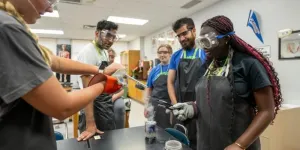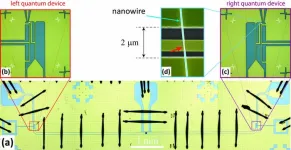(Press-News.org) Neuroscientists had a problem.
For decades, researchers had a theory about how an animal’s brain keeps track of where it is relative to its surroundings without outside cues – like how we know where we are, even with our eyes closed.
According to the theory, which was based on brain recordings from rodents, networks of neurons called ring attractor networks maintain an internal compass that keeps track of where you are in the world. An accurate internal compass was thought to require a large network with many neurons, while a small network with few neurons would cause the compass’s needle to drift, creating errors.
Then researchers discovered an internal compass in the tiny fruit fly.
“The fly’s compass is very accurate, but it’s built from a really small network, contrary to what previous theories assumed,” says Janelia Group Leader Ann Hermundstad. “So, there was clearly a gap in our understanding of brain compasses.”
Now, research led by Marcella Noorman, a postdoc in the Hermundstad Lab at HHMI's Janelia Research Campus, explains this conundrum. The new theory shows how it is possible to create a perfectly accurate internal compass with a very small network, like in fruit flies.
The work changes the way neuroscientists think about how the brain carries out many tasks, from working memory to navigation to decision-making.
“This really expands our knowledge of what small networks can do,” Noorman says. “They actually can do a lot more complicated computations than previously known.”
Generating a ring attractor
When Noorman arrived at Janelia in 2019, she was presented with the problem Hermundstad and others had been puzzling over: How could the fruit fly’s small brain generate an accurate internal compass?
Noorman first set out to show that you couldn’t generate a ring attractor with a small network of neurons, but that you needed to add “extra stuff” -- like other cell types and more detailed biophysical properties of the cells – to get it to work. To do that, she stripped away all the “extra stuff” from existing models, to see if she could generate a ring attractor with what was left over. She thought this wouldn’t be possible.
But Noorman struggled to prove her hypothesis. That’s when she decided she needed a different approach.
“I had to flip my mindset and think, well, maybe it’s because you can generate a ring attractor with a small network,” she says, “and then figure out what specific conditions the network has to satisfy to make that happen.”
By changing her assumption, Noorman discovered that, in fact, it is possible to generate a ring attractor with as few as four neurons, as long as the connections between them are carefully adjusted. Noorman worked with other researchers at Janelia to test the new theory in the lab, finding physiological evidence that the fly brain can generate a ring attractor.
“Smaller networks and smaller brains can perform more complicated computations than we previously thought,” Noorman says. “But, to do so, the neurons have to be connected much more precisely than they would otherwise need to be in a larger brain where you can use a lot of neurons to perform the same computation.”
“So there’s a trade-off between how many neurons you use for this computation and how carefully you have to connect them,” she says.
Next, the researchers plan to explore whether the “extra stuff” might provide additional robustness to the ring attractor network, and whether the base computation could serve as a building block for more complicated computations in bigger networks with multiple variables. Additional experiments could also help researchers understand how the connections between neurons in the network are adjusted and how sensory cues might impact the network’s representation of head direction.
For Noorman, a mathematician turned neuroscientist, it has been challenging but fun to figure out how to translate biology into a math problem that can be solved.
“The fly’s head direction system is the first example of neural activity that I’d ever seen, so it’s been fun to actually figure out and understand how that works,” she says.
END
Small brains can accomplish big things, according to new theoretical research
2024-10-03
ELSE PRESS RELEASES FROM THIS DATE:
UTA professor honored for science education leadership
2024-10-03
University of Texas at Arlington UTeach Master Teacher Karen Jo Matsler will be awarded the 2025 Melba Newell Phillips Medal in January from the American Association of Physics Teachers (AAPT) in recognition of her extensive contributions to physics education and her tireless efforts to support educators nationwide. Founded in 1930, AAPT is a national organization dedicated to advancing the teaching and understanding of physics.
For more than 20 years, Dr. Matsler has been a tireless advocate of physics education, working with state legislators and educational agencies ...
Decline of mpox antibody responses after modified vaccinia Ankara–Bavarian Nordic vaccination
2024-10-03
About The Study: The modified vaccinia Ankara–Bavarian Nordic (MVA-BN) vaccination generated mpox antibodies that waned by 6 to 12 months. In participants who received 2 doses of MVA-BN vaccine, mpox antibody responses at 12 months were comparable to or lower than peak antibody responses in people receiving 1 dose, which provided limited protection.
Quote from corresponding author Dan H. Barouch, MD, PhD:
“In this observational study, we show that mpox antibody responses decline 6-12 months following Jynneos (MVA-BN) vaccination. Our data suggest that protective immunity may ...
Wider use of convalescent plasma might have saved thousands more lives during pandemic
2024-10-03
A new study led by researchers at Johns Hopkins Bloomberg School of Public Health estimates that thousands of lives could have been saved during the first year of the COVID-19 pandemic if convalescent plasma had been used more broadly, particularly in outpatients at high risk for severe disease and in hospitalized patients during their first few days of admission.
Convalescent plasma from patients who had recovered from COVID was used starting in the early months of the pandemic at the urging of a group of physicians who cited the blood ...
Strong coupling between Andreev qubits mediated by a microwave resonator
2024-10-03
Quantum communication and quantum computing operate based on quantum bits (qubits) as the smallest unit of information — related to bits in a classical computer. Of the many different approaches currently being investigated around the world, one promising option is to use Andreev pair qubits.
These qubits are formed at interfaces between a metal and a superconductor in a process known as Andreev reflection. Here, an electron from the metal enters the superconductor, where it becomes part of an electron pair (a Cooper pair) — while a hole, ...
UNF biological sciences professor receives NIH grant to study muscle atrophy
2024-10-03
Jacksonville, Fla. – A University of North Florida biology professor has been awarded a prestigious four-year National Institutes of Health (NIH) grant totaling over $720K to study the functional role of an enzyme called dual-specificity phosphatase 4 (Dusp4) in skeletal muscle atrophy.
Dr. David Waddell’s NIH-funded research project will help contribute to knowledge about skeletal muscle atrophy associated with neuromuscular disorders, neurodegenerative diseases and aging. Skeletal muscle atrophy is a decrease in muscle mass that occurs when protein degradation exceeds protein ...
Child Health Day 2024: influenza vaccine protects children from infection and hospitalization for the disease, Spanish study shows
2024-10-03
A study published on Eurosurveillance has demonstrated that Spain's influenza vaccination campaign for children aged 6-59 months during the 2023/24 season was effective in preventing acute respiratory infections (ARI) and hospitalisation, as vaccination was recommended for this age group at the national level for the first time.
In the context of Child Health Day 2024, this research emphasises that continued efforts should be made to increase vaccination coverage among children for future seasons.
Context and methods
Influenza A was dominant in the 2023/2024 season, ...
Announcing the 2024 Glenn Foundation Discovery Awards: Jeffrey Friedman, MD, Ph.D/ (the Rockefeller University) and Myriam Heiman, Ph.D. (MIT)
2024-10-03
Santa Barbara, CA and New York, NY -- The Glenn Foundation for Medical Research (GFMR) and the American Federation for Aging Research (AFAR) are pleased to announce the 2024 recipients of the Glenn Foundation Discovery Awards: Jeffrey Friedman, MD, PhD (Professor, The Rockefeller University and Investigator, Howard Hughes Medical Institute) and Myriam Heiman, PhD (Associate Professor of Neuroscience, Massachusetts Institute of Technology).
The Glenn Foundation Discovery Award supports research projects with strong potential to develop pioneering discoveries to understand ...
Stem cell transplants close macular holes in monkeys
2024-10-03
Human stem cell transplants successfully repaired macular holes in a monkey model, researchers report October 3rd in the journal Stem Cell Reports. After transplantation, the macular holes were closed by continuous filling of the space with retinal tissue.
“We confirmed for the first time in a non-human primate model that embryonic stem-derived retinal organoid sheet transplantation facilitates the closure of macular holes,” says senior study author Michiko Mandai of the Kobe City Eye Hospital. “Our results suggest that this method could become a practical, safe, and effective ...
Our brains divide the day into chapters. New psychology research offers details on how.
2024-10-03
The moment a person steps off the street and into a restaurant—to take just one example—the brain mentally starts a new “chapter” of the day, a change that causes a big shift in brain activity. Shifts like this happen all day long, as people encounter new environments, like going out for lunch, attending their kid’s soccer game, or settling in for a night of watching TV.
But what determines how the brain divides the day into individual events that we can understand and remember separately? That’s what a new paper in the journal Current Biology aimed to find ...
Fear of cancer recurrence in adult survivors of childhood cancer
2024-10-03
About The Study: Decades following treatment, one-third of childhood cancer survivors in this study reported elevated fear their cancer will recur or a subsequent malignant neoplasm will develop. Findings suggest that fear of cancer recurrence should be routinely screened, and clinically significant symptoms intervened upon as a part of survivorship care.
Corresponding Author: To contact the corresponding author, Nicole M. Alberts, PhD, email nicole.alberts@concordia.ca.
To access the embargoed study: Visit our For The Media website at this link https://media.jamanetwork.com/
(doi:10.1001/jamanetworkopen.2024.36144)
Editor’s ...

